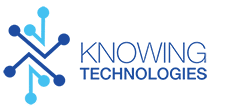As schools are preparing for possible closures in response to growing concerns about the spread of COVID-19, a wide variety of resources have been created and shared within teaching communities. But despite the wealth of tool-based support in the educational community, not all schools have been able to create an instructional-based response, should the crisis force closure of the school. For this reason, Knowing Technologies recommends that schools take the time to create a concise educational continuity plan in support of a necessary transition to distance learning, in addition to other essential response plans. Approaches for creating an educational continuity plan within a distance learning model are shared below, including key questions schools should be asking.
Educational continuity plans provide the framework within which teaching and learning will continue at a school in the event of a prolonged closure. At minimum, the plan should include 4 parts:
- An outline of the tools and resources available to faculty and students
- A high-level description of definitions of success in a distance learning model
- Expectations for engagement
- Distance learning scenarios for potential short, mid, and long-term school closures
Teacher input and involvement in the process of making decisions and creating a plan around them is critical for the success of an educational continuity plan. Not only will teachers provide essential input into the plan, but it may be the case that teachers will also provide each other with the first line of support in using technology in meaningful ways in support of distance learning through sharing ideas, lesson plans, and approaches to engaging students. If at all possible, schools should consider using an inservice day to build a complete plan and offer training while teachers are together.
Describing the School Technology Infrastructure
An educational continuity plan should include a description of the tools and resources available to the community, including details about an LMS, G Suite (Google tools), software subscriptions (e.g., BrainPOP, Screencastify, Seesaw, etc.), and any other tools that should be familiar to teachers and students. The technology infrastructure description should also provide an overview of the student (and faculty) device program to ensure that faculty understand what tools are available to students who will be working remotely, based on what the devices can and cannot easily do (e.g., capturing media on Chromebooks).
Some questions to consider:
- What does the school’s device program look like? Is it uniform for all students?
- What are the core technology tools that the school uses on a daily basis?
- Does the school use an LMS, and if so, how?
- Does the school use G Suite tools, and if so, how?
- Are there any other essential applications that students regularly use, e.g., Seesaw?
- What is required at each student’s home? What kind of Internet connection? Computer?
Though schools should not try to do too much too soon with digital technology, they must consider how to communicate while remote from their peers and from students, which may be new for many in the community. Screencasting, by which students and teachers can record and share videos of their screen, will likely become an important method of communication, as will video conferencing, in both synchronous and asynchronous formats. See Knowing Technologies’ distance learning resources for suggestions on screencasting, video conferencing, and other potentially useful technology tools.
Defining Pedagogical Approaches
It is not necessary to engage with students in new and unfamiliar ways when moving to an entirely remote model. Instead, schools should define their approach to teaching and learning around what they are already doing well, especially with respect to technology use. The approach to engaging students will always be more important than the tools used for the work, understanding that technology does not provide the only solution in a distance learning setting. Through the effective use of educational technology, however, essential pedagogical features like reflection, feedback, and creativity can continue to be supported through this kind of approach (see Knowing Technologies’ Asynchronous Learning Guide for more information on such approaches).
Before setting expectations for a distance learning model, schools should consequently consider what successful outcomes look like for students and design activities based on their own definitions within their educational model. Remote learning, whether in a synchronous or asynchronous approach, should be more than “busy” work, and so it is again important that teachers contribute to the target outcomes defined in the educational continuity plan.
When considering what success looks like, schools can ask themselves questions about their current approach:
- What is the definition of successful engagement within a distance learning model?
- How is success defined in the context of asynchronous and remote learning?
- What does the school already do well with technology? How can it be amplified according to the definition of successful teaching and learning?
- How much technology needs to be used to support the desired learning objectives?
A full discussion of curricular considerations for online/remote learning is beyond the scope of this particular post, though below are listed some key approaches that may be useful for teachers designing digital activities with students:
- Can curriculum be “chunked” into smaller units that make the learning process more manageable for students (see Google’s distance learning webinar for more on the idea)?
- How might the typical curricular pace be slowed to accommodate a remote environment with less contact with teachers?
- How can traditional classroom-based attendance tracking be complemented, or replaced, by asynchronous engagement strategies, i.e., not marking students present if they attended a synchronous video meeting, but marking them “attended” if they complete requisite tasks?
Setting Expectations
In order to facilitate effective communication and collaboration within the community, e.g., from teachers to students, teachers to parents, and teachers to teachers, schools must make key decisions about expectations for their distance learning model. For example, schools should consider how much synchronous vs. asynchronous instruction teachers are expected to support, how teachers will measure attendance, and how often and in what manner will the faculty come together for virtual meetings. Differentiating expectations across grade levels will also be essential, given that younger students may not have access to or facility with devices in the same ways as their older peers.
Note that for accreditation purposes for independent schools in CA, CAIS requires schools to document 3.5 hours per day of learning activities for students in grade 2 and above. Activities teachers design for students should thus include an estimate of the time students will spend completing them. Other expectations can be built by thinking about some essential questions:
- How will the school use the existing technology infrastructure, e.g., LMS expectations, G Suite expectations including Google Docs, other software tool use, etc.?
- How will teachers and students communicate? How frequently? Will there be synchronous instruction, and if so, how and when?
- Where will assignments and student work be shared and how frequently?
- What belongs in a complete remote lesson plan?
- How do teachers take student attendance, and what attendance categories indicate that a student participated remotely?
- What is the daily and weekly schedule in each division? Synchronous and/or asynchronous? What should the class day look like? Do longer, but fewer, class sessions make sense? What should be the daily and weekly schedule?
- Is any training necessary for using the expected technology tools? If so, how?
- How will technology support work for those who encounter issues?
- How should expectations differ for younger students?
- How do students access counseling and other support services? What should educators look out for to determine a student in duress?
- Will the school issue cart-based devices to students who do not have 1:1 devices?
- What happens when a student’s technology fails? What resources are available to them, and who staffs the support system?
The answers to these questions should be clearly described in the educational continuity plan for the entire community’s benefit, along with the understanding that expectations may evolve or change over time. With the technology framework, definitions of success, and expectations in place, schools can then develop implementation plans for various closure scenarios.
Building Distance Learning Scenarios
With an overview of the school’s technology infrastructure, definitions of success, and expectations for teaching and learning set, schools can next create implementation plans around different distance learning scenarios. It may be helpful, for instance, to create a scenario for a short-term closure (e.g., a couple days), and mid-term closure (e.g., a couple weeks), and a worst-case scenario of a long-term closure (e.g., longer than two weeks). The plan for each scenario should clearly articulate the goals within the scenario, including pedagogical targets discussed above, as well as the technology tools that the school will support.
Short-Term Closure—A model in which schools are closed for only a couple days would not force schools to make major changes to their standard mode of interaction with students (e.g., not needing to record attendance, create additional instructional expectations, etc.). Still, expectations and a plan should be in place for the scenario, in the event that schools need to close for a few days (including closing for internal professional development work).
Mid-Term Closure—Mid-term closures on the order of a couple weeks will necessarily force schools to make important decisions about the delivery of instruction. As described above, schools will need to set expectations for communication and the cadence for messages, attendance, synchronous vs. asynchronous expectations, a daily learning schedule organized by week or content area, etc., all of which will likely diverge from practices that teachers and students are accustomed to.
Some expectations based on a school that uses an LMS and G Suite tools are offered below—the decisions shared here are only offered as examples and do not necessarily reflect recommendations by Knowing Technologies. Expectations determined by schools will vary, of course, pending the decisions they make for their communities.
- The school will operate with a fixed daily schedule that balances synchronous and asynchronous learning opportunities for students (e.g., students do math between 9-10am on specified days within a block schedule format)
- Student work involving educational technology will target reflection, feedback, student agency, and creativity
- Attendance must be recorded for synchronous activities, including weekly advisory group meetings
- Teachers will share lesson plans daily on the school’s LMS or send email with links to Google Docs for younger students, and lesson plans will include estimated time for completing the work
- Google Meet will be used for synchronous meetings and collaboration sessions, and videos will be recorded
- Teachers will use screencasting for sharing content with students asynchronously
- Teachers in grades 6+ will host weekly office hours with students or make appointments for checking in
An example of a skeletal plan outlining some of the possible decisions and expectations for a mid-term school closure is shared below:
|
Grade |
Communication | Learning Tools | Schedule |
Attendance |
|
K-2 |
• Daily email to parents • Daily screencasting greeting for students |
• Completely asynchronous
• Work shared in “learning bundles” with Google Docs • Screencast videos twice per week |
Asynchronous activities as described in learning bundles | Based on completion (indicated by families) |
|
3-5 |
• Daily email to parents • Daily announcement on Seesaw for students |
• Synchronous community meetings/morning meetings/advisory
• Screencast videos twice per week • Asynchronous assignments in Seesaw |
Flexible, scheduled blocks online, with mixture of synchronous and asynchronous activities | Encouraged when synchronous, however, reflective activities post-meeting if students cannot make it |
|
6-8 |
• Daily post on LMS for students • Weekly email to parents |
• Synchronous community meetings/morning meetings/advisory
• Screencast videos three times per week • Asynchronous work using screencasting |
• Synchronous blocks in the day
• Synchronous office hours and check-in meetings • Asynchronous time for work to be submitted |
• Required when synchronous • Based on completion (submitted work in LMS) |
|
9-12 |
Daily post on LMS for students | • Synchronous community meetings/morning meetings
• Screencast videos every day • Asynchronous and independent work |
• Synchronous blocks in the day
• Synchronous office hours and check-in meetings • Asynchronous time for work to be submitted |
• Required when synchronous • Based on completion (submitted work in LMS) |
Long-Term Closure—In a worst-case scenario in which schools are closed for a month or longer, clear expectations and educational objectives must again be set, as outlined above in the mid-term scenario plan. In addition to the delivery of quality teaching and learning experiences, schools will also have to consider how to maintain community relationships and the development of social-emotional skills for students.
While a school’s educational continuity plan will build on what schools are already doing well, long-term closures may require teachers to acquire some new skills or approaches for working with students in an extended remote setting. Professional development around learning new approaches or acquiring skills with new technology tools will thus be an important consideration in this scenario. Here are some ideas to consider:
- Adjusting and “chunking” curriculum to accommodate an extended distance learning model (see Pedagogical Approaches above for more on the approach)
- Flexible teaching and learning methods, e.g., project-based learning, student portfolios, passion projects, etc.
- Different approaches to assessment and demonstrations of understanding
- Reflective synchronous conferencing with students and parents to review progress
Summary
Several educational continuity plans are making their rounds online, including the plans shared by Iolani School and Sacred Heart Preparatory (see more online learning guides here). But schools should not believe that they need to craft the perfect resource ahead of a potential closure, given that the plan will likely evolve, alongside the community response to the crisis. Provided that the school leverages its internal capacity, whether through an inservice day with all teachers or in a task force of representative faculty across the school, the foundation of a plan can be built in a relatively short period of time.




